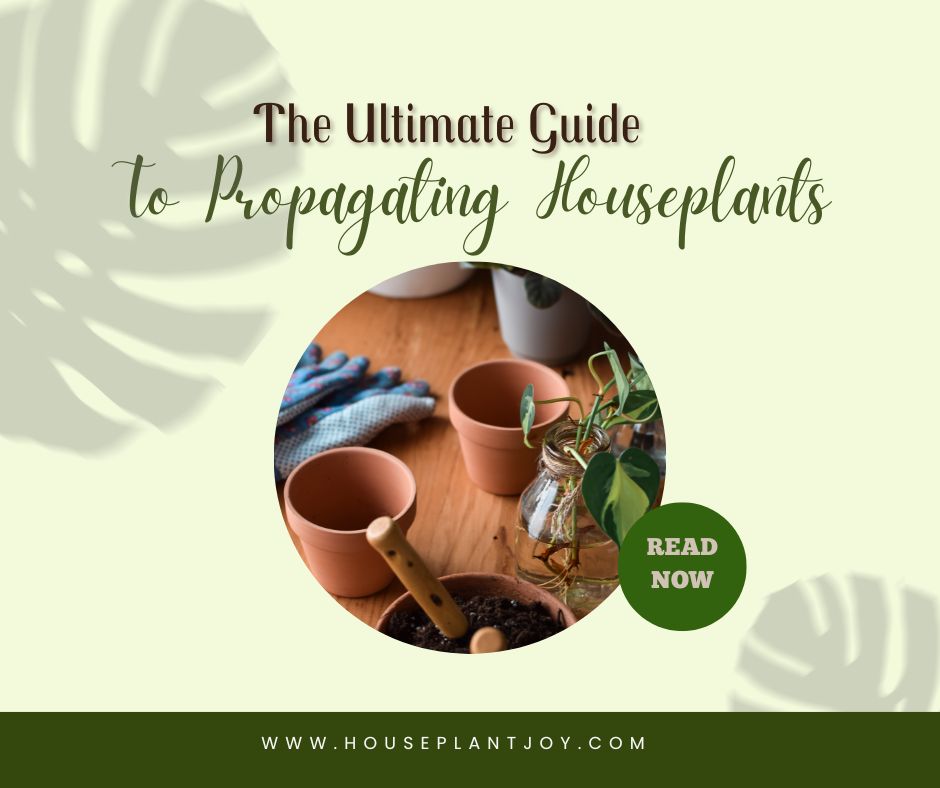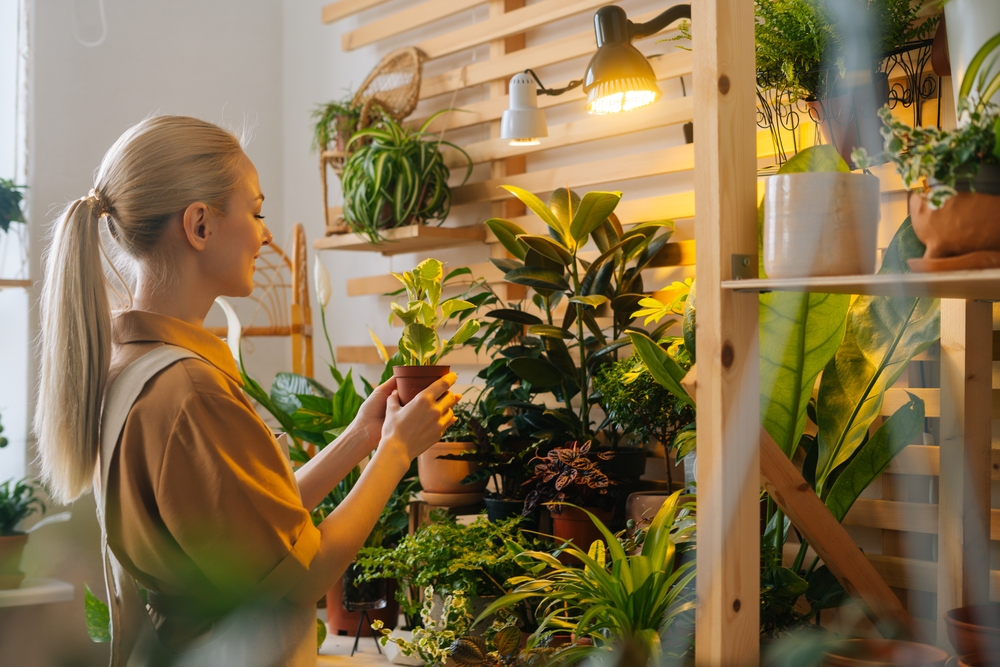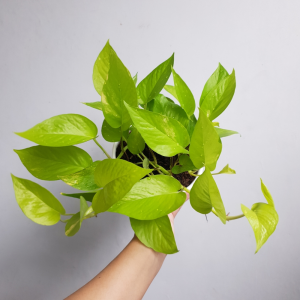HousePlantJoy is supported by our audience. When you purchase through one of our links, we may earn a small affiliate commission. As an Amazon Associate I earn from qualifying purchases. Your cost is not affected.
==================
Propagating house plants is like making plant photocopies. Imagine taking a small part of your favorite plant and using it to grow an entirely new one. You heard me right—more green friends without spending extra cash. Isn’t that awesome?
So, are you ready to dive into the leafy world of stem cuttings, leaf cuttings, and even more? Stick around! This article will explore the simple yet exciting process of turning one plant into many. Trust me, your house plants will thank you!
Stay tuned because, by this end, you’ll have all the info you need to start propagating houseplants like a pro! Enjoy reading!
The Science Behind Propagation
So, you’re probably wondering, “How does this whole plant-copying thing work?” Great question! Let’s dive into the basics of propagating house plants.
First off, let’s chat about what propagation means. It’s a big word, but it’s simple. Propagation is how you create new plants from existing ones. It’s like magic, but for real!
You might have noticed that snake and ZZ plants have identical parts. For snake plants, it’s those tall, pointy leaves. In ZZ plants, it’s the glossy leaves on each stem. These are the keys to making more plants!
The main pieces of a plant you’ll use for this are leaf cuttings or stem cuttings. You can snip these from the parent plant (the original plant you’re trying to copy).
When you place these cuttings in the right potting mix and give them some time, they start to grow new roots. Yep, you’ll soon see tiny roots poking out, and before you know it, you have a brand-new plant!
Tools Needed for Propagating Houseplants
Before jumping into the how-tos of stem and leaf cuttings, let’s get our toolkit ready. You won’t need a lot, but a few essentials can make propagating houseplants much easier (and more fun!).
Sharp Scissors or Knife
Okay, first, you’ll need something sharp to take your cuttings. A pair of sharp scissors, shears, or a knife works best. The cleaner the cut, the better chance your new plant has of growing those crucial new roots.
Potting Mix
You can’t just use any old dirt from the yard. A well-draining potting mix is your best friend here. It helps the root growth without keeping the soil too wet, which could lead to root rot.
Small Pots or Containers
Remember, your new plants are just babies. They don’t need a huge pot. Small pots or containers are just fine to start with.
Rooting Hormone
You might hear about rooting hormones and wonder, “Do I need this?” While it’s not 100% necessary, a little dab can help your cuttings grow roots faster. It’s like plant vitamins!
Clear Plastic Bags or Wrap
Covering your new plant with a clear plastic bag helps keep the moisture in. It gives your new plants a mini-greenhouse vibe, encouraging new growth.
Optional: Plant Labels
If you’re propagating houseplants from multiple parent plants, labels can be super helpful. That way, you don’t mix your spider plant with your snake plants.
How to Propagate Houseplants from Stem Cuttings
Alright, you’ve got your toolkit ready—now let’s make some plant magic happen! In this section, we’re going to focus on two super-popular methods. These are leaf cuttings and stem cuttings. Trust me, they’re easier than you think!
Locate a Healthy Stem
Find a stem with multiple leaves on your parent plant. Cut it, making sure you have at least 4-6 inches of stem.
Potting Mix Prep
Just like before, fill a small pot with well-draining potting mix.
Plant the Stem
Plant the stem in the potting mix. You can use rooting hormone here too, if you’d like.
Bag or No Bag
For stem cuttings, the clear bag is optional. Some plants prefer a little more air.
Root and Grow
Place your pot in indirect light and keep the soil slightly moist. Before you know it, your stem cutting will start to grow new roots and leaves!
How to Propagate Houseplants from Leaf Cuttings
So you loved the idea of leaf cuttings, huh? Awesome, let’s dive into that method a bit more! You’ll see how using just one leaf can create a whole new plant, perfect for expanding your indoor jungle.
Picking the Right Leaf
Let’s start with picking the perfect leaf from your parent plant. You want a leaf that’s healthy and vibrant—no brown or yellow spots. A leaf that’s full of life is more likely to grow into a happy, new plant.
Snip and Dip
Once you’ve got that perfect leaf, use your sharp scissors or knife to snip it off. Make sure to get as close to the base as possible. Now, if you have rooting hormone, this is the time to dip the cut end into it. This helps encourage new roots to grow.
The Right Soil Matters
Next, grab a small pot and fill it with your well-draining potting mix. Trust me, your leaf will thank you for the good soil. The right potting mix helps the roots grow without making them too wet.
Planting Time!
Now comes the fun part! Take your leaf and insert the cut end into the potting mix. You don’t need to bury it deep—just enough to hold it up.
Keeping Things Cozy
Remember those clear plastic bags I mentioned? Well, they’re not just for food. Put one over your newly planted leaf. This helps keep the potting mix moist and gives your new plant a cozy, humid environment to grow in.
Patience is a Virtue
And now we wait. Place your leaf in a spot with indirect light and keep an eye on the soil. In a few weeks, you should see signs of new growth. Yep, that means your leaf is on its way to becoming a brand-new plant!
Water Propagation
Okay, so you’ve mastered leaf cuttings and stem cuttings. But have you tried water propagation? Trust me, it’s a real game-changer. This is especially true if you’re the type who loves to watch roots grow right before your eyes!
The Power of a Glass Jar
So, what’s the first thing you’ll need? A glass jar or a clear container. Why? Because with water propagation, you can actually see the roots grow. It’s all kinds of exciting!
Pick Your Plant
Not all plants are perfect for water propagation, but many are! If you’ve got a spider plant or a snake plant, you’re in luck. These houseplants are great candidates.
The Cutting Ceremony
Just like before, find a healthy stem or leaf on your parent plant. Use those sharp scissors or knives to make a clean cut. Dip the end in rooting hormone if you have some—it’s extra helpful in water too!
Into the Water You Go
Fill your glass jar with water and place the cutting into it. Make sure the cut end is submerged, but try to keep any leaves out of the water to avoid rot.
Window Sill Magic
Find a sunny window sill for your jar. The indirect light will do wonders for root growth.
New Roots, New Growth!
In a few weeks, you should start to see new roots form. It’s so cool watching this happen! Once the roots are a couple of inches long, they’re ready to move to potting mix.
Transition Time
When the roots look strong enough, gently move your cutting from the water to a small pot filled with well-draining potting mix. And voila, you’ve got a brand new plant that you propagated yourself!
Propagating Specific Types of Houseplants
So you’ve got the general idea of how to propagate houseplants, but what about specific types? Not every plant likes to be propagated the same way, you know. Let’s look at a couple of fan favorites and how best to multiply them.
Snake Plants
Snake plants are one of the most painless plants to propagate. Seriously, if you’re a newbie, start with these! You can use both leaf cuttings and water propagation methods for snake plants. Just follow the steps from earlier, and you’ll soon have a whole family of snake plants!
ZZ Plants
ZZ plants are another low-maintenance joy. You can easily propagate them using leaf cuttings. Stick them in a well-draining potting mix and wait for the new roots and shoots to appear. It’s that simple!
Spider Plants
Spider plants naturally produce offsets, or baby plants, right off the main plant. These babies make it super easy to propagate new plants. Simply cut them off and plant them in moist potting soil or let them root in water. Easy-peasy!
Christmas Cactus
Propagating Christmas cactus is a bit different. For these, use stem cuttings. Let the cut ends dry for a few hours before planting them in a well-draining potting mix. These plants prefer indirect light and will give you with new growth in just a few weeks.
African Violets
African violets need a bit more care. Use a leaf and some of its stem to propagate. Plant this in a small pot with a well-draining potting mix. Cover with a clear plastic bag and keep in indirect light. Before you know it, new plants will start to appear at the base of the leaf.
How to Care for Your New Plants After Propagation
Yay, you did it! But now what? Like any new parent, you must know how to take care of your baby plants.
Adjusting to a New Home
First of all, please make sure to plant your rooted cuttings in a small pot with a well-draining potting mix. Your new plants need a cozy home to continue their growth.
Light and Love
Please place them in a bright area with indirect light. Too much direct sun can be hard on them initially, but they need good light to grow well.
Water Wisely
When it comes to watering, less is more. Make sure the potting mix is moist but not too wet. Overwatering can result in root rot, and we don’t want that!
Fertilizing
Hold off on the fertilizer for a little while. Your new plants have enough on their plates right now with all this growing they’re doing. Wait a few weeks before starting any feeding.
Snug and Warm
Please keep them in a warm place, especially during the first few weeks. Remember, they’re still babies and need that extra warmth to encourage new growth.
Observe and Adapt
Keep an eye on your new plants. You’ll learn quite a lot just by watching them. Are they looking droopy or yellow? They might need more light or less water. And remember, the goal is for your new plants to one day become mature, just like their parent plant.
Wrapping It Up
Wow, what a ride, right? We’ve gone from the basics of how to propagate houseplants all the way to caring for your brand-new leafy babies. I’m super excited for you to start your own propagation adventures!
Remember, each plant is unique, just like us. Some might prefer stem cuttings, while others are all about those leaf cuttings. And hey, don’t forget about the fun of water propagation!
Propagating houseplants is more than just a hobby; it’s a way to multiply the joy plants bring into our lives. And the best part? You get to share that joy with friends and family by gifting them new plants that you’ve lovingly grown.
Before we part ways, here’s my last piece of advice: be patient and observant. Your plants will tell you what they need if you just pay attention. It might take a few weeks or even months, but you’ll see those new roots and leaves pop up soon enough.
Thank you for hanging out with me and learning about this amazing world of plants. You’re now ready to expand your indoor jungle or even start one if you’re new to this.
Let’s keep that green thumb working and propagate some more houseplants, shall we?
FAQs
Can I propagate any house plant?
Most plants can be propagated, but the method might differ. Some plants, like snake plants and ZZ plants, are super easy to propagate from leaf cuttings. Others might need stem cuttings or even a more advanced technique like air layering.
How long does it take for new roots to grow?
Great question! The time for root growth can vary from a couple of weeks to a few months. This depends on the plant type and conditions like warmth and humidity. Just be patient; you’ll soon see those new roots sprouting.
Do I need rooting hormone?
Rooting hormone can boost the process and increase your chances of successful propagation. However, many plants, like spider plants and snake plants, can root just fine without it. It’s your call!
Learn More About Propagating Houseplants!
Discover the most houseplants and how to propagate them! Join us on Facebook, Instagram, and Twitter for beautiful photos, plant care tips, and a community that celebrates the joy of indoor gardening.
Facebook: https://www.facebook.com/houseplantjoyblog
Instagram: http://instagram.com/houseplantjoy20
Twitter: https://twitter.com/HouseplantJoy
Let’s nurture our green spaces together!











